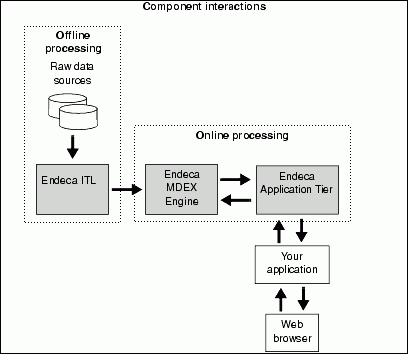The Endeca IAP has three major components.
- Endeca Information Transformation Layer (ITL)
- Endeca MDEX Engine
- Endeca Application Tier
These components interact with your data sources and application as shown in the following figure.

The Endeca Information Transformation Layer (ITL) reads your raw source data and manipulates it into a set of Endeca MDEX Engine indices. The ITL consists of the Content Acquisition System (which includes the Endeca CAS Server and Console, the CAS API and the Endeca Web Crawler), and the Data Foundry (which includes data-manipulation programs such as Forge).
The Endeca MDEX Engine is the query engine that is the core of the Endeca IAP. The MDEX Engine consists of the Indexer (Dgidx), the Dgraph, and the Agraph. The MDEX Engine loads the indices generated by the indexing component of the Endeca Information Transformation Layer. Although the Indexer (also known as Dgidx) is installed as part of the MDEX Engine package, in effect it is part of the ITL process.
After the indices are loaded, the MDEX Engine receives queries from the Endeca Application Tier, executes them against the loaded indices, and returns the results to the client Web browser. The Application Tier provides an interface to the MDEX Engine. The two default interfaces, which can be used in the same application, are the Presentation API and the Web services interface. The Endeca RAD (Rapid Application Development) Toolkit for ASP.NET can also be used. These interfaces are used to query the MDEX Engine and manipulate the results.
The Endeca ITL components, such as Forge, are run offline at intervals that are appropriate for your business requirements. The Endeca MDEX Engine and Endeca Application Tier are both online processes, meaning they must remain running as long as you want clients to have access to your data set.
